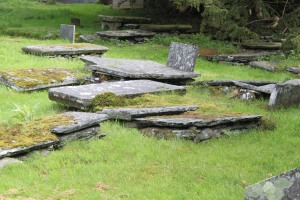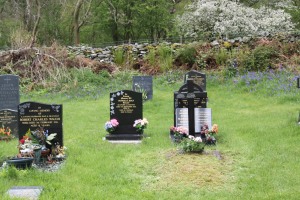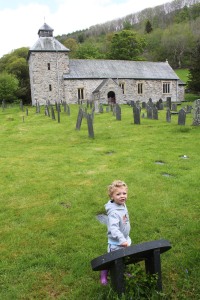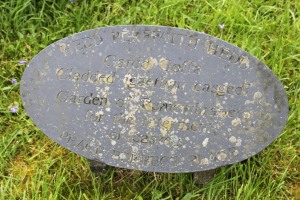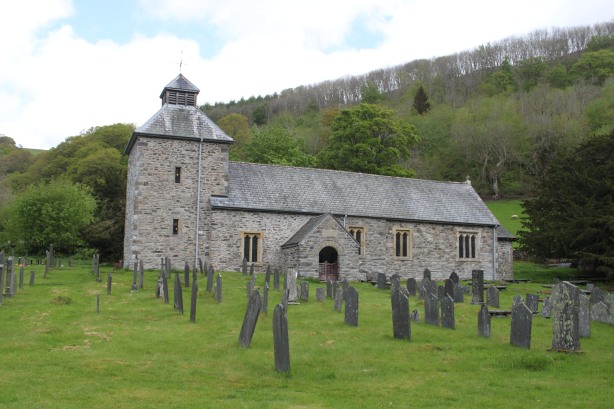
Pennant Melangell church
This is re-posted from Howard Williams’s Archaeodeath blog.
Recently I posted about a visit to Pennant Melangell and the shrine of St Melangell. Well, it must be said that this is a fascinating site for its church and internal memorials, but even more so for its churchyard.
Many urban,suburban and large rural churchyards (whether in use or abandoned) have very complex patterns of memorialisation with multiple foci to them. In such environments, the bodies of the dead compete with each other, jostling down the generations within the restrictions of limited space. From the 19th century in particular, some churchyards bear signs of a new trend of expansion rather than reuse.
This expansion of burial space is because of a mix of factors: rising demographics, increasing social and economic wealth, a professional funerary culture, the industrial revolution facilitating the transportation and hence availability of stone for memorials, as well as the rising social and aesthetic desire to be memorialised in stone among both the middle and working classes. In this context, we can chart not only shifts in the form of memorials, but also a clear horizontal stratigraphy away from the church. Often, the oldest gravestones will be close to the building while the most recent with the furthest away, perhaps in one, two or more stages. Further complex patterns occur where there is no space to extend the churchyard because of existing restrictions and so separate cemeteries may have to be used.
Horizontal Stratigraphy
The churchyard at Pennant Melangell presents a simple but different phenomenon from those mentioned above. In this circular, large space there is a clear horizontal stratigraphy but it operates in an arc around the church rather than increasingly distant from it.
This spatial progression is partly because of the size of the churchyard boundary combined with the small scale of the burial population the church served. As such it is a brilliant example to share with students, since CPAT conducted a full churchyard survey and can map out the shift in commemoration over time. The earliest gravestone dates to 1619 in the south-east quadrant. Here we see no graveyard extensions but instead a clockwise movement of the dead from the south-east to the south, to the south-west to the north-west of the churchyard. In the 19th century gravestones go vertical, then become more modest again as they progress ever west and northwards.
And then there is the north of the churchyard. Excavations revealed unmarked graves to the north of the church, but this was clearly a sheltered and unfavoured spot for burial; a phenomenon recently discussed in print by Bob Silvester of CPAT.
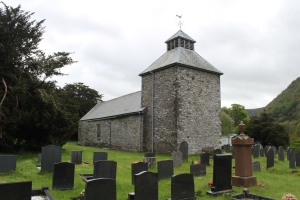
The empty north side of the churchyard, populated only by the most recent inhumation graves
Cremation Switchback
Despite the relatively little competition for burial space in this rural Welsh churchyard, Pennant Melangell displays a far broader phenomenon I am researching with regard to cremation burial zones and gardens of remembrance.
First this involves the bifurcation of the cremated and inhumed dead into separate zones. So at Pennant Melangell this means that the most recent graves are in two locations, the inhumation graves are north-west of the church at the furthest extent of the clockwise progression of burials, while the cremation burials are in a separate location south of the church.
Second it involves a switchback: with cremations added in older areas of the churchyard and/or closer to the church. In the case of Pennant Melangell, the garden of remembrance is on the south side, in an area last regularly populated with new memorials in the early 20th century.
What this tells us is that while the cremated dead may undergo very similar funerals, they have a very different spatio-temporal trajectory both during the funeral (bearing in mind that the nearest crematoria is probably Wrexham or Shrewsbury) and afterwards (with cremation burials located separate from near-contemporary inhumed individuals). There are undoubtedly many lessons here for archaeologists studying ancient cemeteries, but also this is a largely overlooked, varied and complex, yet very significant shift in how we utilise churchyards and cemeteries.
This is a theme I will be exploring for English and Welsh cathedrals in Strand 1 of the Past in its Place project. Going somewhere less cluttered and rural like Pennant Melangell, however, helps us to discern the big picture operating at the episcopal sees that are the focus of this project.

